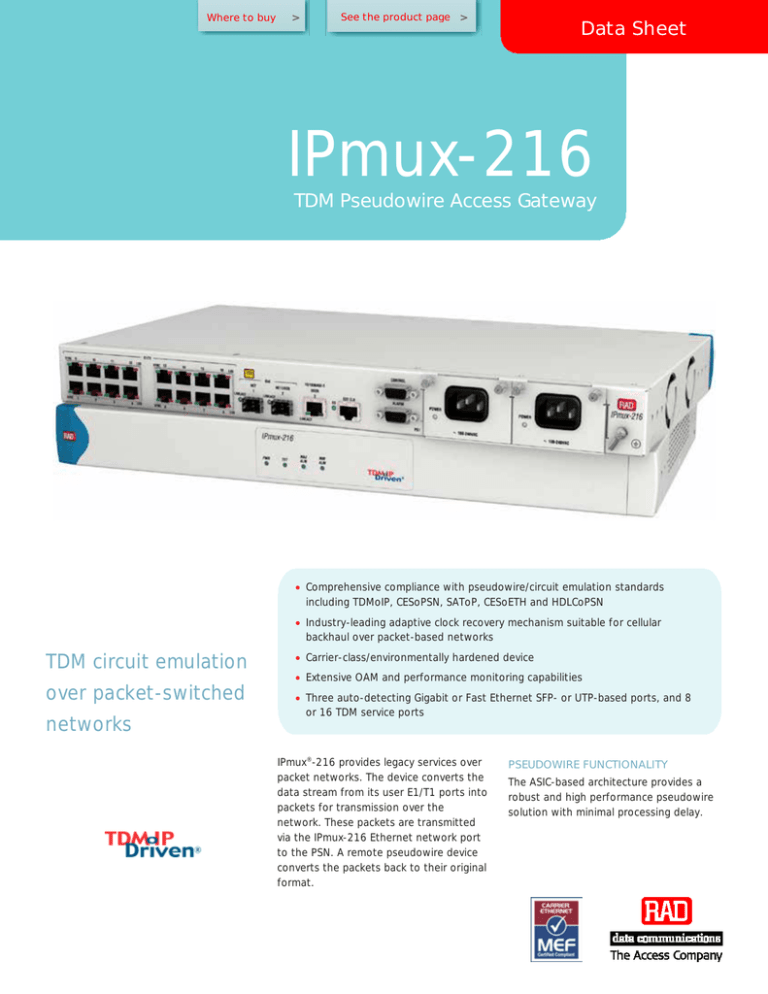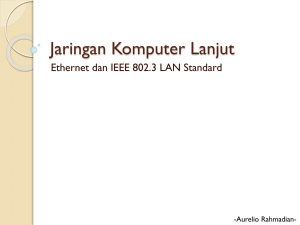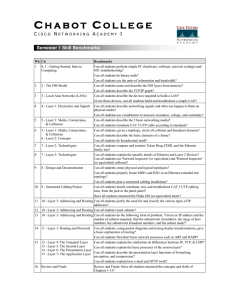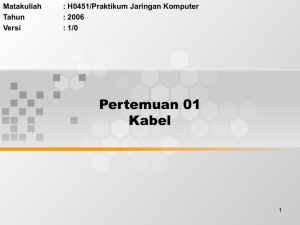IPMUX-216 Technical Specifications
advertisement

Where to buy > See the product page > Data Sheet IPmux-216 TDM Pseudowire Access Gateway · Comprehensive compliance with pseudowire/circuit emulation standards including TDMoIP, CESoPSN, SAToP, CESoETH and HDLCoPSN · Industry-leading adaptive clock recovery mechanism suitable for cellular backhaul over packet-based networks TDM circuit emulation over packet-switched networks · Carrier-class/environmentally hardened device · Extensive OAM and performance monitoring capabilities · Three auto-detecting Gigabit or Fast Ethernet SFP- or UTP-based ports, and 8 or 16 TDM service ports IPmux®-216 provides legacy services over packet networks. The device converts the data stream from its user E1/T1 ports into packets for transmission over the network. These packets are transmitted via the IPmux-216 Ethernet network port to the PSN. A remote pseudowire device converts the packets back to their original format. PSEUDOWIRE FUNCTIONALITY The ASIC-based architecture provides a robust and high performance pseudowire solution with minimal processing delay. IPmux-216 TDM Pseudowire Access Gateway The unit employs various pseudowire encapsulation methods, including TDMoIP, CESoPSN, SAToP, CESoETH (MEF 8) and HDLCoPSN. PSEUDOWIRE TIMING TDM INTERFACE End-to-end synchronization between circuits is maintained by deploying advanced clock recovery mechanisms. 8 or 16 E1 or T1 ports provide connectivity to any standard E1 or T1 device. Proper balance between PSN throughput and delay is achieved via configurable packet size. Clock recovery conforms to G.823 and G.824 traffic interface using G.8261-defined scenarios. The E1 and T1 interfaces feature: · Integral LTU/CSU for long haul applications A jitter buffer compensates for packet delay variation (jitter) of up to 180 msec in the network. Advanced clock recovery conforms to G.823 synchronization interface using G.8261-defined scenarios and achieves 16 ppb clock accuracy. · G.703 and G.704 framing modes · CAS and CRC-4 bit generation (E1) · D4/SF and ESF framing (T1) · Robbed bit (T1). PSEUDOWIRE QoS/CoS Ethernet networks – outgoing pseudowire packets are assigned a dedicated VLAN ID according to 802.1q and marked for priority using 802.1P bits. IP networks – outgoing pseudowire packets are marked for priority using DSCP, ToS, or Diffserv bits. The system clock ensures a single clock source for all TDM links. The system clock uses master and fallback timing sources for clock redundancy. IPmux-216 also provides system clock input and output via an external clock port. MPLS networks – outgoing pseudowire packets are assigned to a specific MPLS tunnel and marked for priority using EXP bits. Figure 1. 2G/3G Cellular Backhaul Data Sheet ETHERNET INTERFACE The following Ethernet ports are available: · One network port · One network/user port · One user port. The Ethernet ports accept a wide range of Gigabit and Fast Ethernet SFP-based fiber optic and electric, as well as built-in UTP interfaces. ETHERNET CAPABILITIES IPmux-216 features an internal bridge, operating in VLAN-aware and VLAN-unaware modes. VLAN stacking is used for traffic separation between different users or services, by defining a service provider VLAN ID per customer or service. When VLAN stacking is used, a service provider VLAN tag is added to the user traffic and removed from network traffic. Both service provider VLAN ID and service provider VLAN priority can be defined. IPmux-216 provides four priority queues for each port or pseudowire traffic flow. User traffic can be prioritized according to VLAN priority, DSCP, IP Precedence or per port. Ingress and egress rate can be limited per user and network port. Rate limitation is configured per packet type. ETHERNET RING TOPOLOGIES A G.8032 Layer-2 Ethernet ring is used by IPmux-216 for traffic protection. This technology builds a logical ring, defined as a set of IEEE 802.1-compliant bridges, and protects against link and node failures. To achieve this, every node in the ring has two bridge ports connected to adjacent nodes. The ring itself is constructed independently of the transport technology used at the server layer. Failures in the ring are detected by using Ethernet OAM (Y.1731) continuity check (CC) messages between adjacent nodes. In addition, the unit employs Resilient Ethernet Ring technology to construct a self-healing Ethernet fiber ring topology (ring resiliency is similar to that of SDH/SONET networks). In case of link failure on any segment of the ring, the pseudowire traffic is rerouted within 50 ms. A single ring supports up to 16 nodes. Figure 2. Private or Leased Line over PSN ETHERNET LINK PROTECTION The unit performs link aggregation (LAG) based on 802.3ad requirements. Dual homing technology (1:1) allows IPmux-216 to be connected to two different upstream devices. PSEUDOWIRE TRAFFIC PROTECTION Pseudowire traffic can be backed up at the pseudowire connection level. This allows setting a different path for the primary and secondary PW bundles. Both bundles can be routed to the same or different destinations and operate in the 1+1 and 1:1 modes. In 1:1 redundancy with two remote devices the PW bundles in the remote units operate in “mate” mode. In this mode each device monitors traffic on a mate bundle and transfers data only when the other bundle is inactive. IPmux-216 TDM Pseudowire Access Gateway ETHERNET SERVICE OAM (802.1ag) The unit uses the end-to-end Ethernetlayer OAM protocol for proactive connectivity monitoring, fault verification, and fault isolation, according to the IEEE 802.1ag and ITU-T Y.1731 requirements. LINK OAM (IEEE 802.3ah) Link-layer OAM according to IEEE 802.3ah is used for fault indication and loopback activation response. MANAGEMENT IPmux-216 can be configured and monitored locally via an ASCII terminal, or remotely via Telnet/SSH, Web browser or RADview. Preserves investment in legacy equipment in migration to PSN Management traffic can run over a dedicated VLAN. The RADview Service Center and Element Manager packages control and monitor pseudowire devices and circuits. The Service Center’s intuitive GUI, “point andclick” functionality and easy-to-follow wizards increase the efficiency and accuracy of the service provisioning process. IPmux-216 performs RADIUS client authentication. Using SSH and SSL encryption protocols allows secure communication over potentially insecure IP-based networks. The Syslog protocol is used by IPmux-216 to generate and transport event notification messages over IP networks to the central Syslog server. The Syslog operation is compliant with the RFC 3164 requirements. SNMPv3 support introduces a user-based security model, enhances authentication and encryption techniques, and ensures management traffic security. Each management and service host has a separate MAC address. As the unit provides one default gateway, the user can also specify static routes to enhance the IP routing capabilities of the management and pseudowire traffic. Software is downloaded via the local terminal, using XMODEM, or remotely, using TFTP. After downloading a new software version, IPmux-216 automatically saves the previous version in non-volatile memory for backup purposes. Similarly, copies of the configuration file may be downloaded and uploaded to a remote workstation for backup and restore purposes. Data Sheet OAM AND DIAGNOSTICS The following RFC-2495 E1/T1 physical layer performance statistics are available: LOS, LOF, LCV, RAI, AIS, FEBE, BES, DM, ES, SES, UAS and LOMF. IPmux-216 performs an internal built-in test (BIT) after power-up. The results of the test are visible via the local terminal. LAN and IP layer network condition statistics, such as packet loss and packet delay variation (jitter) are monitored and stored by the device. Fault isolation, statistics and event logging are available. Fault propagation initiates service port alarms, e.g. E1/T1 LOS, to reflect network fault conditions. Alarms detected at service ports are propagated to the remote pseudowire device via the packet network. Diagnostic loopbacks can be activated inband. Ethernet and IP-layer network condition statistics, such as packet sequence errors (loss or misorder) and packet delay variation (jitter), are monitored and stored by the device. RAD’s TDM PW OAM mechanism verifies connectivity, measures round trip delay and prevents pseudowire configuration mismatch. SIMPLE NETWORK TIME PROTOCOL IPmux-216 employs Simple Network Time Protocol (SNTP) for propagating and receiving time information on a network, according to SNTPv4 (RFC 4330) requirements. SNTP is used to configure data and time by learning the information from a single or multiple NTP servers. The clock can be configured to a local time by defining UTC and DST offsets. ENVIRONMENT IPmux-216/H is an environmentally hardened version intended for street-cabinet and cellular-tower installations. Notes: The /H version requires temperature hardened SFP transceivers. Figure 3. Delivering Ethernet and TDM Services over Fiber Ring in the First Mile IPmux-216 TDM Pseudowire Access Gateway Specifications Signal Levels Receive: E1 INTERFACE 0 to -36 dB with LTU (long haul) Number of Ports 8 or 16 0 to -10 dB without LTU (short haul) Compliance ITU-T Rec. G.703, G.704, G.706, G.732, G.823 Transmit balanced: ±3V ±10% Transmit unbalanced: ±2.37V ±10% Data Rate 2.048 Mbps Jitter and Wander Performance Per AT&T TR-62411, ITU-T G.824 (for internal, loopback and external clock modes) Line Code HDB3 Connector Balanced: RJ-45 Framing Unframed, framed, multiframe; with or without CRC-4 Unbalanced: BNC (RJ-45 to BNC adapter cable is supplied) Lowers Opex of TDM Signaling CAS, CCS (transparent) service by utilizing Line Impedance 120W, balanced packet infrastructure 75W, unbalanced Data Sheet T1 INTERFACE Number of Ports 8 or 16 Compliance ANSI T1.403, ITU-T Rec. G.703, G.704, G.824 Data Rate 1.544 Mbps Line Code B8ZS, B7ZS, AMI Framing Unframed, SF, ESF Signaling CAS (bit robbing), CCS (transparent) Line Impedance 100W, balanced Jitter and Wander Performance Per AT&T TR-62411, ITU-T G.824 (for internal, loopback and external clock modes) Connector RJ-45 ETHERNET INTERFACE Compliance IEEE 802.3, 802.3u, 802.1p&Q Number of Ports 3, network or user Port Combinations 3 fiber optic SFPs 2 fiber optic SFPs + 1 UTP 1 fiber optic SFP + 2 UTPs 3 UTPs Carrier-grade voice quality without Signal Levels Receive: 0 to -36 dB compression, or Transmit pulse amplitude: silence suppression ±3V ±20%; 0 dB, -7.5 dB, 15 dB (CSU), user-selectable ±2.7V ±10%, 0 to 655 feet, (DSU), user-selectable IPmux-216 TDM Pseudowire Access Gateway PSEUDOWIRE GENERAL Compliance IETF: RFC 4553 (SAToP), RFC 5087 (TDMoIP), RFC 5086 (CESoPSN), RFC 4618 (excluding clause 5.3 – PPP) Timing (per Port) Internal ITU-T: Y.1413 with increased pseudowire capacity and service management capabilities Adaptive MEF: 8, 9, 14 (EPL-certified) External input or output via dedicated port: E1/T1 or 2048/1544 kHz squarewave (RS-485 electrical levels) Number of PW Connections 256 Management SNMPv1, SNMPv3 Jitter Buffer Size 0.5–180 msec (unframed) with 0.1 msec granularity Telnet 2.5–180 msec (framed) with 0.5 msec granularity ASCII terminal via V.24 (RS-232) DCE port MFA: IA 4.1, IA 8.0.0 Enhances performance Loopback IPmux-216/A Adaptive Clock Frequency accuracy: ±16 ppb and G.823 synchronization interface requirements (clause 6), when locked to a PRC (stratum 1) or SSU (stratum 2) clock Frequency accuracy in holdover: ±16 ppb ±1 ppb of aging per day RADview Service Center TDMoIP (ordered separately) Diagnostics E1/T1 local loopback E1/T1 remote loopback Facility Type 1 (FAC1) inband loopback CSU loopback as per Telecordia GR-54 Data Sheet Statistics E1/T1 (per G.826 and RFC 2495) Power AC: 100–240 VAC Ethernet (per RFC 2819) DC: 24 VDC (20 to 36 VDC) or -48 VDC (-40 to -70 VDC) Jitter buffer indication (overflow, underflow, sequence error) Alarm Relay Via dedicated DB-9 female connector Indicators PWR (green) – Power TST (yellow) – A diagnostic loopback MAJ. ALARM (red) – Major alarm MIN. ALARM (red) – Minor alarm SYNC (green) – E1/T1 synchronization LOS (red) – Critical alarm on a TDM port LINK (green) – Ethernet link ACT (yellow) – Ethernet activity SD (green/red) – External clock POWER (green) – Power supply connection Power Consumption 27W max Physical Height: 43 mm (1.7 in) Width: 440 mm (17.5 in) Depth: 240 mm (9.4 in) Weight: 3.6 kg (7.9 lb) Environment Temperature: IPmux-216: 0 to 50°C (32 to 122°F) IPmux-216/H: -30 to 65°C (-22 to 149°F) Humidity: Up to 90%, non-condensing IPmux-216 TDM Pseudowire Access Gateway Table 1. IPmux Family Product Comparison Feature IPmux-2L (Ver. 1.0) IPmux-4L (Ver. 1.0) IPmux-4L (GbE) (Ver. 2.0) IPmux-16L (Ver. 1.0) IPmux-24 (Ver. 3.5) TDM service ports 1, 2 ´ E1 2, 4 ´ E1 4 ´ E1 8, 16 ´ E1 1, 2, 4 ´ E1/T1 Ethernet network ports 1 ´ FE 1 ´ FE 1 ´ GbE network, 2 ´ GbE network/user Ethernet subscriber 1 or 2 ´ FE ports 1 or 2 ´ FE 4 ´ FE Number of PWs 63 64 64 Multi-pseudowire P P Advanced clock recovery – Redundant power supply 3 ´ GbE network/user 3 ´ FE network/user IPmux-216 (Ver. 3.5) 8, 16 ´ E1/T1 1 ´ GbE/FE network, 1 ´ GbE/FE network 1 ´ GbE/FE 1 ´ GbE/FE network/user network/user 1 ´ GbE/FE 1 ´ GbE/FE 256 64 256 P P P P P P P P P – – – – – P External clock port – – – P Optional P Serial data port Optional – – – – – SSH, SSL, RADIUS – – – – P P Network management system RV-EMS RV-EMS RV-EMS RV-EMS RV-SC/TDMoIP, RV-EMS (basic shelf view) RV-SC/TDMoIP, RV-EMS (basic shelf view) Data Sheet Ordering STANDARD CONFIGURATIONS +1 Network interface: N SFP-ready slot IPMUX-216/48R/16E1CX/N/N/UTP IPMUX-216/48R/16E1CX/UTP/UTP/UTP Fast Ethernet/STM-1, 1310 nm, multimode, LED, 2 km (1.2 mi) 7 2 Fast Ethernet/STM-1, 1310 nm, single mode, laser, 15 km (9.3 mi) Gigabit Ethernet, 1550 nm, single mode, laser, 80.0 km (49.7 mi) 8 2H Fast Ethernet/STM-1, industrially hardened, 1310 nm, single mode, laser, 15 km (9.3 mi) Gigabit Ethernet, 1310 nm, single mode, laser, 40.0 km (24.8 mi) 8H Gigabit Ethernet, industrially hardened, 1310 nm, single mode, laser, 40.0 km (24.8 mi) IPMUX-216/48R/16T1/UTP/UTP/UTP IPMUX-216/48R/8T1/UTP/UTP/N 3 IPMUX-216/AC/16E1CX/UTP/UTP/UTP IPMUX-216/AC/16E1/UTP/UTP/UTP Fast Ethernet/STM-1, industrially hardened, 1310 nm, single mode, laser, 40 km (24.8 mi) 4 Fast Ethernet/STM-1, 1550 nm, single mode, laser, 80 km (49.7 mi) IPMUX-216/ACR/16E1/UTP/UTP/UTP IPMUX-216/ACR/16T1/UTP/UTP/UTP IPMUX-216/ACR/8T1/UTP/UTP/UTP SPECIAL CONFIGURATIONS IPMUX-216/@/?/~/$/+1/+2/+3 Legend @ Power supply: AC Single 100 to 240 VAC 24 Single 24 VDC 48 Single -48 VDC ACR Dual 100 to 240 VAC 24R Dual 24 VDC 48R Dual -48 VDC AC24 One 100 to 240 VAC and one 24 VDC AC48 One 100 to 240 VAC and one -48 VDC ? Enclosure (Default=regular enclosure): H Environmentally hardened enclosure ~ Clock recovery mechanism (Default=standard clock recovery): A Advanced clock recovery (per TDM port) $ TDM interface: 8E1 8 balanced E1 interfaces 8E1CX 8 unbalanced E1 interfaces 8T1 8 balanced T1 interfaces 16E1 16 balanced E1 interfaces 16E1CX 16 unbalanced E1 interfaces 16T1 16 balanced T1 interfaces Note: Unbalanced E1 interfaces are provided via RJ-45 to BNC adapter cables supplied with the product. Fast Ethernet/STM-1, 1310 nm, single mode, laser, 40 km (24.8 mi) 3H IPMUX-216/AC/8T1/UTP/UTP/UTP IPMUX-216/ACR/16E1CX/UTP/UTP/UTP Gigabit Ethernet, industrially hardened, 1310 nm, single mode, laser, 10.0 km (6.2 mi) 1 IPMUX-216/48R/16E1/N/N/UTP IPMUX-216/48R/16E1/UTP/UTP/UTP 6H 10A Fast Ethernet/STM-1, Tx – 1310 nm, Rx – 1550 nm, single mode (single fiber), laser (WDM) , 20 km (12.4 mi) 10B Fast Ethernet/STM-1, Tx – 1550 nm, Rx – 1310 nm, single mode (single fiber), laser (WDM) , 20 km (12.4 mi) 18A Fast Ethernet/STM-1, Tx – 1310 nm, Rx – 1550 nm, 9/25 single mode (single fiber), laser (WDM), 40 km (24.8 mi) 17A Gigabit Ethernet, Tx -1310 nm, Rx -1490 nm, single mode (single fiber), laser (WDM), 10.0 km (6.2 mi) 17B Gigabit Ethernet, Tx -1490 nm, Rx -1310 nm, single mode (single fiber), laser (WDM), 10.0 km (6.2 mi) 20 Gigabit Ethernet, 1550 nm, single mode, laser, 120.0 km (74.5 mi) 22A Gigabit Ethernet, Tx -1490 nm, Rx -1570 nm, single mode (single fiber), laser (WDM), 80.0 km (49.7 mi) 22B Gigabit Ethernet, Tx -1570 nm, Rx -1490 nm, single mode (single fiber), laser (WDM), 80.0 km (49.7 mi) 9F Fast Ethernet, RJ-45 connector, 100m (328 ft) 18B Fast Ethernet/STM-1, Tx – 1550 nm, Rx – 1310 nm, 9/25 single mode (single fiber), laser (WDM), 40 km (24.8 mi) 9G GbE interface, RJ-45 connector, 100m (328 ft) 30 10/100/1000BaseT (with SGMII), RJ-45 connector, 100m (328 ft) 19A Fast Ethernet/STM-1, Tx – 1490 nm, Rx – 1570 nm, 9/25 single mode (single fiber), laser (WDM) , 80 km (49.7 mi) UTP Built-in 10/100BaseT 19B Fast Ethernet/STM-1, Tx – 1570 nm, Rx – 1490 nm, 9/25 single mode (single fiber), laser (WDM) , 80 km (49.7 mi) 5 Gigabit Ethernet, 850 nm, multimode, VCSEL, 0.55 km (0.3 mi) 5H Gigabit Ethernet, industrially hardened, 850 nm, multimode, VCSEL, 0.55 km (0.3 mi) 6 Gigabit Ethernet, 1310 nm, single mode, laser, 10.0 km (6.2 mi) +2 Network/user interface: See the network interface ordering options above Note: It is strongly recommended to order this device with original RAD SFPs installed. This will ensure that prior to shipping, RAD has performed comprehensive functional quality tests on the entire assembled unit, including the SFP devices. RAD cannot guarantee full compliance to product specifications for units using non-RAD SFPs. For detailed specifications of the SFP transceivers, refer to the SFP Transceivers data sheet. +3 User interface: See the network/user interface ordering options above Data Sheet IPmux-216 TDM Pseudowire Access Gateway Network Network/User User N N N N N UTP N UTP UTP UTP UTP UTP UTP UTP N UTP N N SUPPLIED ACCESSORIES Power cord DC power connection kit CBL-RJ45/2BNC/E1/X RJ-45 to BNC adapter cable (if an unbalanced E1 interface is ordered) RM-34 Hardware kit for mounting one IPmux-216 unit into a 19-inch rack Notes: · · The N (SFP-ready slot) option in Table 2 can be replaced with any SFP transceiver supported by IPmux-216. Network and network/user ports must be of the same type: Gigabit or Fast Ethernet. If Gigabit Ethernet functionality is required, order a N option for both network and network/user ports. For Fast Ethernet functionality, you can mix UTP and N options for both ports. OPTIONAL ACCESSORIES IPMUX-216-M/@ Spare power supply module @ Power supply: AC 100 to 240 VAC 24 24 VDC 48 -48 VDC WM-34 Hardware kit for mounting one IPmux-216 unit on a wall CBL-DB9F-DB9M-STR Control port cable International Headquarters 24 Raoul Wallenberg Street Tel Aviv 69719, Israel Tel. 972-3-6458181 Fax 972-3-6498250, 6474436 E-mail market@rad.com www.rad.com North America Headquarters 900 Corporate Drive Mahwah, NJ 07430, USA Tel. 201-5291100 Toll free 1-800-4447234 Fax 201-5295777 E-mail market@rad.com Order this publication by Catalog No. 803807 490-100-10/11 (3.5) Specifications are subject to change without prior notice. ã 1997–2011 RAD Data Communications Ltd. The RAD name, logo, logotype, and the terms EtherAccess, TDMoIP and TDMoIP Driven, and the product names Optimux and IPmux, are registered trademarks of RAD Data Communications Ltd. All other trademarks are the property of their respective holders. Table 1. Valid Port Combinations




